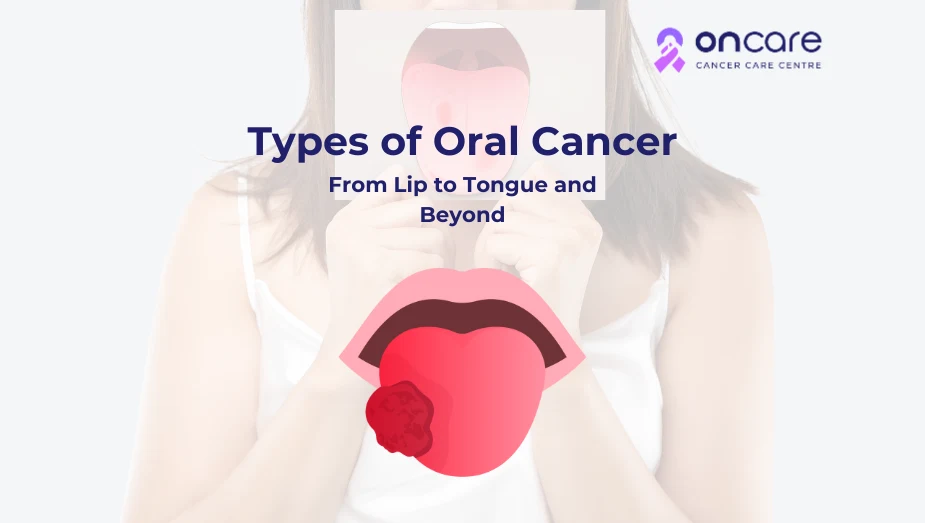Table of Contents
Types of Oral Cancer: From Lip to Tongue and Beyond

Oral cancer is a serious health concern that affects thousands of people across the globe each year. Unfortunately, this health challenge goes unnoticed in the initial stages until it reaches the advanced stages. Oral cancer starts from the lips to the throat and various parts of the mouth; it can develop into different types of cancer. Understanding the types of oral cancer can be vital for early diagnosis, effective cancer treatment, and improved treatment outcomes.
In this article, we’ll look closer into the types of oral cancer, risk factors for oral cancer, and early warning signs to watch out for!
Lip cancer
Lip cancer can develop anywhere along the upper or lower lip but is most common on the lower lip. It usually affects the lower lip due to greater sun exposure. This type of cancer can only reduce the risk of your lip cancer by protecting the face from the sun with a sunscreen cream or wearing a hat. If you are someone who smokes, then try to quit smoking.
It often appears as:
- Mouth sores that doesn’t heal
- Pain, numbness or tingling on the lips or mouth
- Loose teeth
- Bleeding or thickening of the lips
- Swollen jaw
- Persistent lump or ulcers
- Discoloration of lips
Tongue cancer
Tongue cancer develops when cells on the tongue start to grow and divide uncontrollably. The tongue starts from the hyoid bone which is located where your tongue meets the neck, that ends at the floor of the mouth.
If the cancer develops in the front part of the tongue, then doctors will call it an oral cancer or or oral tongue cancer. If the cancer develops on the back portion of the tongue, then the doctors call it oropharyngeal cancer or base of tongue cancer.
It often appears as:
- Red (erythroplakia) or white (leukoplakia) patches on the tongue
- A sore that doesn’t heal or bleeds easily
- Pain while swallowing
- Hoarseness
- Loose teeth
- A sore throat that doesn’t go away (Chronic pharyngitis)
- A red or greyish ulcer on your tongue that doesn’t go away
Gum cancer
Gum cancer is classified under the head and neck cancer that begins when cells in the upper or lower gums, which grows out of control and forms lesions or tumors uncontrollably. These types of cancers are usually mistaken as gingivitis.
Symptoms of these cancers may include:
- White, red, or dark patches on the gums
- Bleeding or cracking of the gums
- Experiencing thick areas of the gums
Floor of mouth cancer
Floor of the mouth cancer is a type of cancer that starts as a growth of cells under the cells. The floor of the mouth cancer generally begins in the thin, flat line cells inside the mouth also known as squamous cells. When the cancer starts in these cells it's called squamous cell carcinoma.
This floor of the mouth cancer causes changes in the look and feel of the tissue under the tongue. One of the changes may include a lump or sore that doesn’t heal.
Symptoms may include:
- Mouth pain
- Sores in the mouth that doesn’t heal
- Trouble moving the tongue
- Loose teeth
- Pain with swallowing
- Weight loss
- Ear pain
- Experiencing pain in the neck
- White patches in mouth that doesn’t go away
Palate cancer
Palate cancer is a type of cancer developed on the roof of your mouth. This is a rare form of oral cancer. This palate cancer includes squamous cell carcinoma and certain types of salivary gland cancer.
Symptoms of palate cancer may include:
- Bad breath (halitosis)
- Trouble swallowing (dysphagia)
- Loose teeth
- A lump in your neck
Buccal Mucosa cancer
This type of cancer is a rare cancer that develops in the inner cheek of the mouth. Buccal mucosa cancer is a type of neck and head cancer. The buccal mucosa usually extends from the inside of the cheeks and just behind the last teeth as well. This is a type of soft, wet mucus membrane that’s made up of several layers of the tissue.
Some symptoms may include:
- Bad breath
- Difficulty in opening mouth
- Loose teeth
- Lump in your neck from a swollen lymph node
- Numbness in the mouth
- Experiencing difficulty swallowing
- Swelling of the jaw
Salivary gland cancer
Salivary gland cancer is a type of malignant tumour that mostly affects the salivary glands. The salivary glands are generally located in the mouth and throat. It produces saliva also known as spit, which helps the digestive system begin breaking down food.
Some of the symptoms may include:
- Experiencing numbness in the face, neck, jaw or mouth
- Continuous pain in the face, neck, jaw or mouth
- Difficulty opening the mouth
- Trouble swallowing
- Experiencing bleeding from the mouth
Oropharyngeal cancer
Oropharyngeal cancer develops in the middle section of the throat (pharynx) that makes saliva, which keeps the throat and mouth moist and digests the food. A doctor uses different treatment methods to cure this cancer, but it can recur even after the treatments.
You can reduce the risk of developing this cancer with the help of getting the human papillomavirus (HPV) vaccine, not smoking cigarettes, and reducing excessive alcohol consumption.
It often appears as:
- A sore throat that doesn’t go away
- Pain or difficulty in swallowing (dysphagia)
- A lump in the throat and neck
- Sudden weight loss
- Blood in the cough
- Trouble in the mouth opening (trismus)
- Ear pain
- Voice change that doesn’t go away
Risk factors for oral cancer
The risk factors are some factors that increase the risk of oral cancer in a person. Understanding what increases the risk can lead to proactive and preventive actions against oral cancer.
Key risk factors may include:
- The use of tobacco products
- Excessive alcohol consumption
- Human papillomavirus (HPV) infection
- Excessive sun exposure (lip cancer)
- Poor oral hygiene and chronic irritation
Warning signs to watch out for
If you notice any of these symptoms lasting for more than 2 weeks, then do not ignore it! Consult a dentist immediately.
Symptoms may include:
- Mouth sores that doesn’t heal soon
- Lumps or thickening in the mouth
- Difficulty chewing or swallowing foods
- Experiencing numbness or tingling in the mouth
- Continuous hoarseness
- Sore throat
Consult Today
From lip to tongue and beyond, oral cancer can develop anywhere in your mouth. Fortunately, early diagnosis and immediate treatment can potentially improve the survival rates of patients. Practicing regular dental checkups and self-examination is your first line of defense against oral cancer.
At Oncare, we offer premium-quality cancer treatments including advanced cancer surgeries at affordable price ranges with experienced cancer specialist consultation.
If you or any loved ones of yours are diagnosed with cancer, then visit Oncare Cancer Center and book an appointment with our cancer specialist today! Get an estimated cost of your cancer treatments today!
Frequently Asked Questions
Oral cancer tests may include:
- Physical examination
- Brush biopsy
- Incisional biopsy
- Indirect laryngoscopy and pharyngoscopy
- Direct pharyngoscopy and laryngoscopy
The most common surgeries for oral cancers are:
- Primary tumor surgery
- Glossectomy
- Mandibulectomy
- Maxillectomy
- Sentinel lymph node biopsy
- Neck dissection
- Reconstruction surgery
Common treatment option may include:
- Radiation therapy
- Targeted therapy
- Chemotherapy
- Immunotherapy
According to studies, 75% of cases are caused because of these risk factors. Including:
- Smoking habits including cigarettes, pipes or vaping
- Using smokeless tobacco products such as chewing tobacco, dip, snuff or water pipes
- Drinking excessive amounts of alcohol
- Excessive sun exposure to the lips
- Human papilloma virus infection
- Family history of cancer

